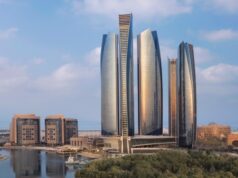TORONTO—A firm advocate of sustainable energy, Fairmont Hotels & Resorts has announced its continued involvement with the Pembina Institute, a leading non-profit environmental organization that actively promotes sustainable energy solutions. As part of this ongoing commitment, Fairmont is expanding the program in 2007 to include all of its corporate office computers across North America.
Since 2006, Fairmont has purchased an equivalent of 390 MwH of wind power to offset the greenhouse gas emissions generated by all of its front desk check-in computers. Made possible by purchasing Eco-Logo certified wind power, Fairmont will now have a total of 837 computers involved in the program resulting in a greenhouse gas reduction of approximately 160 tons for 2006 and 2007 combined.
“Fairmont continues to lead by example with renewable energy solutions that are forward thinking, practical and cost efficient,” says Nancy Hammer, director of development at the Pembina Institute. “In my opinion, Fairmont continues to raise the bar for environmental action in the hospitality industry.”
Complementing its relationship with the Pembina Institute, Fairmont has undertaken a multitude of sustainable energy initiatives. Through its award-winning environmental program, Fairmont’s Green Partnership, properties across the Fairmont chain have incorporated clean energy solutions into their daily operations. These include:
Wind Power
: In Alberta, The Fairmont Chateau Lake Louise has been purchasing green power since 1999 through an agreement with the Canadian Eco-Logo certified Canadian Hydro Developers. Presently 40 percent of the property’s electricity needs are met by a blend of wind and run-of-river electricity generation. Green power, derived from sources including wind, run-of-river hydro, and biomass, has minimal impact on the environment and produces minimal greenhouse gas emissions compared to traditional generation methods. In the United States, The Fairmont Washington, D.C., has partnered with Pepco Energy Services to supply the 415-room hotel with more than 3 million kilowatt hours (kWh) of electricity generated from renewable resources, 10 percent of which will be derived from wind farms located in the Mid-Atlantic region.
Solar Power
: Solar systems have now been installed in nine chalets at Fairmont Kenuak, a collection of 13 cabins located in one of North America’s largest private reserves encompassing 65,000 acres of majestic forests, abundant wildlife and over 70 lakes. Detached from the area’s electrical grid, the chalets currently draw 50 percent of their power from solar means. This energy is then used to power well water pumps, some kitchen and furnace fans, dishwashers, supplementary lighting, and emergency radios, as well as providing limited power for corporate groups to use for audio-visual presentations.
Cogeneration
: In 2006, the Fairmont St. Andrews, Scotland, installed a combined heat and power system that uses a gas-fired engine to drive generators and produce electricity. The waste heat and energy from the exhaust, cooling water and lubricating oil is recovered and converted to power the resort’s space heating and domestic hot water requirements. The new system is estimated to reduce more than 3,000 ton of carbon dioxide annually.
Heat Recovery
: The engineering team at The Fairmont Waterfront installed a heat-recovery system that captures condensate—steam that has been condensed back into water—from domestic hot-water tanks, and then uses it to preheat incoming city water. This process saves an estimated 305,380 kilowatt-hours per year, roughly the same amount of energy it would take to power approximately seven average-sized homes.
Go to Fairmont Hotels & Resorts.







